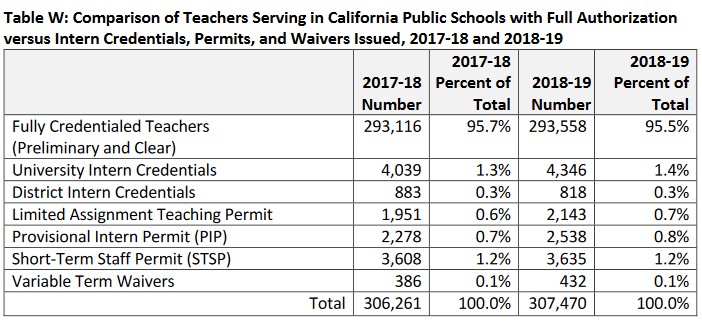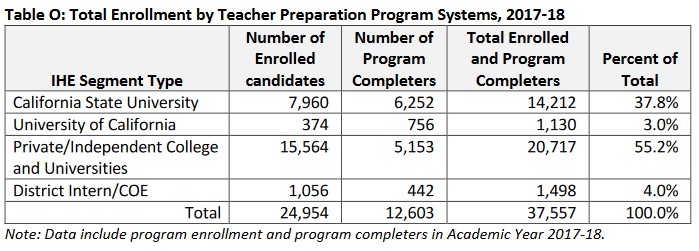Breaking down new teacher credentials
The rise in issued credentials from 16,515 in 2017–18 to 17,019 in 2018–19 (shown in the figure below) largely stems from a 5 percent increase in the number of credentials issued by the state’s institutes of higher education. California State University campuses again led the way, issuing 46.8 percent of all new credentials. The focus on in-state teacher preparation programs is also reflected in a 6.4 percent decrease in credentials issued for individuals who prepared in places outside California or the U.S.
Among other notable statistics:
- Increases were seen in both multiple subject (3.2 percent) and single subject (11.1 percent) credentials issued by California’s institutes of higher education in 2018–19, while education specialist, or special education teacher, issuances dropped by 2.7 percent.
- The state’s higher education system produced three-fourths (75.1 percent) of newly credentialed teachers during 2018–19. Of the 75.1 percent, 53.1 percent came through the traditional student teaching pathway and 22 percent came through the university intern pathway.
- The number of district-prepared credentials issued increased 35.5 percent in 2018–19, from 408 the year prior to 553.
- The number of university intern numbers increased by 7.6 percent in 2018–19 while district/county office of education intern credentials decreased by 7.4 percent.
Short-term permits and waivers increase slightly
Of the 307,470 teachers serving in California’s public schools in academic year 2018–19, 95.5 percent were fully credentialed; in comparison, 95.7 percent were fully credentialed in 2017–18. As districts and COEs address teacher shortages and staffing needs with limited resources and funding, the CTC notes that there have been dramatic increases in both Short-Term Staff Permits (STSPs) and Provisional Intern Permits (PIPs) since 2014–15. In 2018–19, the number of STSPs and PIPs issued increased by 0.7 percent and 11.4 percent, respectively.
A district may request a STSP when there is an “acute staffing need,” or one that exists when they need to fill a classroom immediately based on an unforeseen need. A PIP, meanwhile, may be requested when there is an “anticipated staff need.” This occurs when a district is aware of a pending opening and searches for a credentialed teacher but is unable to recruit one.
Additional teaching authorizations outside of full credentials include university intern credentials, limited assignment teaching permits and variable term waivers, as shown in the following figure.
Increased enrollment in programs; estimated hiring
One strong indicator of potential teacher supply for California’s local educational agencies is the state’s data on teacher preparation program enrollment (as shown below). In its report, the CTC highlights that over the past five academic years, enrollment has surged by about 6,000 candidates, from 18,984 in 2013–14 to 24,954 in 2017–18.








